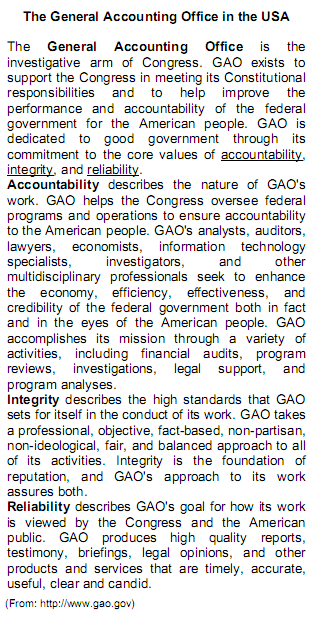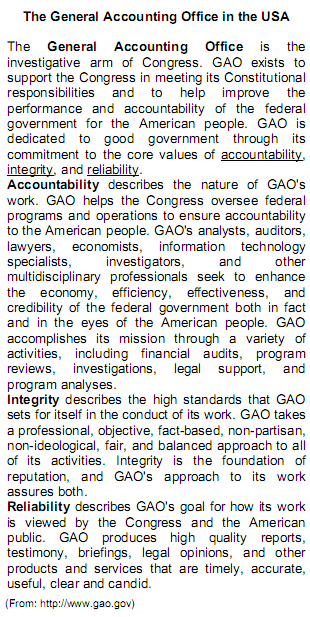Questões sobre Interpretação de Texto
Lista completa de Questões sobre Interpretação de Texto para resolução totalmente grátis. Selecione os assuntos no filtro de questões e comece a resolver exercícios.

The text says that the three essential aims of GAO require it to be
- A.
transparent, honest and dependable.
- B.
credible, secretive and competent.
- C.
able to make good reports, integral and trustworthy.
- D.
open, professionally clueless and effective.
- E.
uncritical, honorable and independent.

The last paragraph points out that the products and services produced by GAO must
- A.
give a broad overview of the topic in hand.
- B.
avoid giving offence to anybody involved.
- C.
use the technical terms appropriate to each task.
- D.
be meticulous, clear and punctually produced.
- E.
always be kept strictly out of the public eye.
LEIA O TEXTO I E RESPONDA ÀS PERGUNTAS DE 11 A 13:
De acordo com o texto, diferentemente dos jardins botânicos, os parques têm por objetivo:
- A.
oferecer uma bela paisagem;
- B.
ajudar o progresso da medicina;
- C.
estimular o estudo das plantas;
- D.
enfatizar o aspecto didático;
- E.
classificar tipos de vegetação.
A expressão such as em "such as the gardens ..." (l.5-6) introduz um (a):
- A.
comparação;
- B.
contraste;
- C.
explicação;
- D.
conseqüência;
- E.
ilustração.
A palavra sublinhada em "while that of a botanical garden..." (l.14-15) substitui:
- A.
science;
- B.
recreation;
- C.
purpose;
- D.
park;
- E.
education.
READ TEXT II AND ANSWER QUESTIONS 14 TO 20:
The author states that in the tropics:
- A.
wheat is the most important carbohydrate;
- B.
barley and oats help people to survive;
- C.
sorghum and rye are important products;
- D.
tapioca is more consumed than wheat;
- E.
potato is the most common carbohydrate.
READ TEXT II AND ANSWER QUESTIONS 14 TO 20:
The function of the text is to:
- A.
criticise;
- B.
inform;
- C.
contradict;
- D.
compare;
- E.
argue.
READ TEXT II AND ANSWER QUESTIONS 14 TO 20:
In "In fact it is sometimes difficult..." (l.12), the underlined expression means:
- A.
really;
- B.
normally;
- C.
mainly;
- D.
honestly;
- E.
finally.
READ TEXT II AND ANSWER QUESTIONS 14 TO 20:
The function of the text is to:
- A.
criticise;
- B.
inform;
- C.
contradict;
- D.
compare;
- E.
argue.
READ TEXT II AND ANSWER QUESTIONS 14 TO 20:
The author says that cereals initially came from:
- A.
cultivated seeds;
- B.
well-known breeders;
- C.
uncultivated grounds;
- D.
selected plants;
- E.
distinct species.


